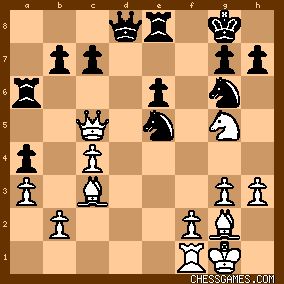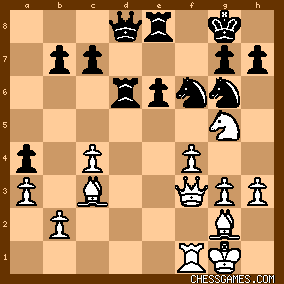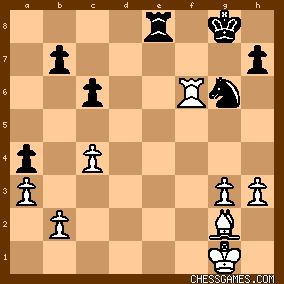KEG: Post II
In the last diagrammed position in my previous post, Schlechter faced a key decision: 17. QxB?
It was tempting to snatch Black's Bishop, but this loses the exchange. Schlechter had correctly foreseen that White would still have the advantage with his two Bishops sweeping the board even after losing the exchange, but with the simple 17. exd3 he would have had a winning game and without needing to sacrifice material. 17... exd2
18. Bc3!
Best. If 18. Rfe1 QxB 19. Ne4 (not Rosenthal's very bad 19. Qe3 QxQ
[and certainly not Rosenthal's 19...Qxb2? 20. Rab1] and White is better) chances would be about equal. With the text, Schlechter--despite loss of the exchange--has the better of the position. 18... exR(Q)+
19. RxQ Nce5
A mistake. 19...Nf8 was much better.
The position was now:

click for larger viewThe power of White's Bishops is impressive. This more than outweighs the lost exchange. But Black is still very much in the game. 20. f4
Better than 20. BxN QxN 21. Qb5 Raa8, though Rosenthal's claim in the Tournament Book that the resulting position favors Black is wrong. 20... Nd7
20...h6 seems better.
21. QE3
21. Qb4 was even stronger.
21... Nf6?
Marshall wants to attack, but 21...c6 was the prudent choice. In what follows, Schlechter repeatedly ignores the chance to win the Black b7 pawn. Assuming the score is correct, I find this curious. Was Schlechter frightened by the tactical prowess of Marshall that had defeated both Lasker and PIllsbury in this tournament. 22. Qf3?
Why not 22. Bxb7?
22... Rd6
And here, why not 22...Rb6 to guard the bb7 pawn. The position was now:

click for larger view23. f5?!
Again ignoring the chance to win the b7 pawn (23. Qxb7). The attack Schlechter initiates with the text only lands him in potential trouble, and ends his winning chances. 23... exf5
24. Qxf5 c6?
The final major mistake is this tipsy-turvy game. Marshall should have played 24...Re7, after which he would have had fair chances of coming out on top. After the text, the game reduces to an ending in which only White has any realistic chance to win. 25. Ne4 Rde6
26. BxN gxB
27. Nxf6+ RxN
28. QxR QxQ
29. RxQ
After the dust cleared, the position was:

click for larger viewIt is not clear that White can win, but I cannot explain Schlechter's failure even to try to avoid a draw. 29... Re2
30. Rf2 Re3
31. Rf3
Why not try 31. Kh2 or even 31. g4?
31... Re1+
32. Rf1 Re2
33. Rf2
And here why not try 33. Rb1?
33... Re3
34. Rf3 Re1+
35. Rf1 Re2
1/2 -- 1/2
It was finishes like this that helped give Schlechter the title of the "drawing" king. | 




